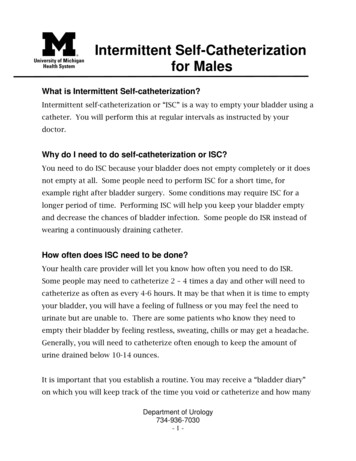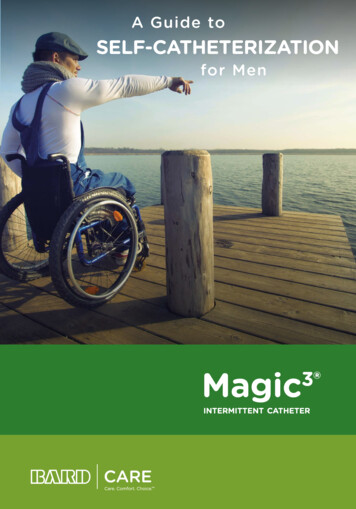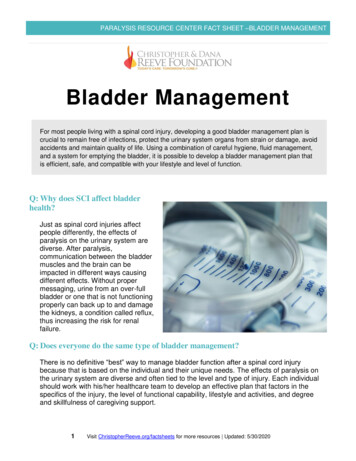
Transcription
Intermittent Self-Catheterizationfor MalesWhat is Intermittent Self-catheterization?Intermittent self-catheterization or “ISC” is a way to empty your bladder using acatheter. You will perform this at regular intervals as instructed by yourdoctor.Why do I need to do self-catheterization or ISC?You need to do ISC because your bladder does not empty completely or it doesnot empty at all. Some people need to perform ISC for a short time, forexample right after bladder surgery. Some conditions may require ISC for alonger period of time. Performing ISC will help you keep your bladder emptyand decrease the chances of bladder infection. Some people do ISR instead ofwearing a continuously draining catheter.How often does ISC need to be done?Your health care provider will let you know how often you need to do ISR.Some people may need to catheterize 2 – 4 times a day and other will need tocatheterize as often as every 4-6 hours. It may be that when it is time to emptyyour bladder, you will have a feeling of fullness or you may feel the need tourinate but are unable to. There are some patients who know they need toempty their bladder by feeling restless, sweating, chills or may get a headache.Generally, you will need to catheterize often enough to keep the amount ofurine drained below 10-14 ounces.It is important that you establish a routine. You may receive a “bladder diary”on which you will keep track of the time you void or catheterize and how manyDepartment of Urology734-936-7030-1-
ounces of urine has drained with either voiding or catheterizing. After youestablish a good routine it is no longer necessary to measure your urine. Thiscould take several weeks or several months. Everyone is differentWhat supplies will I need?Gather the supplies before you begin to do ISR. A catheter that will be prescribed by your doctor. A clean dry storage container to store the catheter if it is being reused Water-soluble lubricating jelly such as K-Y Jelly. Do not use petroleumjelly such as Vaseline. Moist towelette or washcloth for cleaning the urethral opening (meatus). Liquid antibacterial soap without moisturizer and water. A toilet, or a urinal, or a basin for draining and measuring the urine. A clean surface on which to place supplies.How do I self-catheterize?Getting started:1. Wash your hands with warm water and soap and dry with clean towel.2. Place your supplies on a clean surface which can be easily reached.3. Open the catheter package and lubricate 2-4 inches of the catheter tipwith the water soluble jelly.4. Position yourself for comfort during catheterization. You may stand ator sit on the toilet or sit on the edge of a seat using a urinal for drainage.5. Clean the tip of the penis in a circular motion going outward using theantibacterial soap on a wash cloth or with the towelette. Men who are notcircumcised should pull back the foreskin for cleaning.Department of UrologyIntermittent Self-Catheterization for Males-2-
Steps to follow for catheterization:1. Hold the penis at about 45º angle to your stomach.2. Insert the catheter slowly into the urethra using a steady gentle pressure.When you have inserted about six inches you may meet resistance. Thisis because you have reached the area of the sphincter muscle. Use gentlebut firm pressure on the catheter until the muscle relaxes and thecatheter becomes easier to advance. Continue with insertion until yousee the urine flow. Once you see the urine flow, insert the catheter onemore inch, draining the urine into a container that is lower than the levelof the bladder to help with drainage.Department of UrologyIntermittent Self-Catheterization for Males-3-
3. If you are using an angle tip (coude) catheter, be sure the angle is facingupward. Follow the blue line on the clear catheter or the bubble at theopen end on the red rubber catheter as a guide.4. Keep the catheter in your bladder until the urine stops flowing.5. Gradually remove the catheter stopping anytime the urine flows to besure the bladder is empty.6. For single use catheter you can discard the catheter. If it is not a singleuse catheter, place it is a clean storage container. You will recieveinstructions on proper care and storage of catheters.7. Wipe the lubricant off your penis. If you are not circumcised, pull yourforeskin back to its normal position.8. When completely finished, wash your hands with soap and water.Important things to Remember When you are leaving home take several catheters with you so that if youneed to catheterize more than once, you will have a catheter available. Be sure to catheterize as directed by your doctor. Always wash your hands before and after self-catheterization. If your routine is to catheterize every three to four hours, make sure yourfirst time is first thing in the morning and your last time is just beforeyou go to bed. If you go to bed early, and the volume of your first time in the morning isconsistently greater than 14 ounces you will need to catheterize onceduring the night. Drinking enough fluids is important for bladder health. Do not drink lessfluid to decrease the need for self-catheterization. Call your doctor if you have trouble passing the catheter into yourbladder.Department of UrologyIntermittent Self-Catheterization for Males-4-
Do not press down on the bladder to empty it. The bladder will drain bygravity. Hard pressure on the bladder may push urine back into thekidneys.Who do I contact if need more information?If you have any questions, please contact the University of Michigan,Department of Urology at 734-936-7030 during working hours (8:00 am – 5:00pm). After business hours or on weekends, please call 734-936-6267 and ask tospeak with the Urology Resident on Call.What do I need to watch for?Call your doctor if you have any of the following signs and symptoms that mayindicate an infection: Foul smelling urine Cloudy urine Change in color of urine Low-grade fever Unusual dribbling of urineIf you have any of the above symptoms notify your doctor and increase yourfluid intake. If you increase your fluid intake, remember you will need toincrease the number of times you catheterize yourself as well.In people with high spinal cord injury, a bladder that is too full can also causean extremely high blood pressure and headache and can lead to severecomplications. If you have a high spinal cord injury and get a severe headache,empty your bladder immediately.For urgent or emergent situations 24 hours a day, page the Urology Resident oncall at (734) 936-6267. They will contact the doctor for you.Department of UrologyIntermittent Self-Catheterization for Males-5-
If you go to the ER, please ask the ER doctor to contact the University ofMichigan urology resident on call for assistance.Disclaimer: This document contains information and/or instructional materials developed bythe University of Michigan Health System (UMHS) for the typical patient with your condition.It may include links to online content that was not created by UMHS and for which UMHSdoes not assume responsibility. It does not replace medical advice from your health careprovider because your experience may differ from that of the typical patient. Talk to yourhealth care provider if you have any questions about this document, your condition or yourtreatment plan.Author: Opal Patricia Lesse MSN, FNP-BC, DNPReviewers: Deb Spilak RN, Ruti Volk, MSI, AHIPPatient Education by University of Michigan Health System is licensed under a CreativeCommons Attribution-NonCommercial-ShareAlike 3.0 Unported License. The illustrations arenot covered by this license. Last Revised June 1, 2015Department of UrologyIntermittent Self-Catheterization for Males-6-
3. If you are using an angle tip (coude) catheter, be sure the angle is facing upward. Follow the blue line on the clear catheter or the bubble at the open end on the red rubber catheter as a guide. 4. Keep the catheter in your bladder until the urine stops flowing. 5. Gradually remove the catheter stopping anytime the urine flows to be










